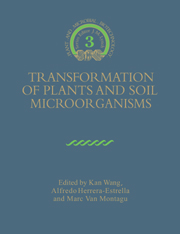Book contents
- Frontmatter
- Contents
- List of Contributors
- Series Preface
- Preface
- Acknowledgements
- Abbreviations and Terms
- Part I Transformation of Soil Microorganisms
- Part II Transformation of Cereal Crops
- Part III Transformation of Industrially Important Crops
- 8 Leguminous Plants
- 9 Spring and Winter Rapeseed Varieties
- 10 Sunflower
- 11 Forest Trees
- Index
9 - Spring and Winter Rapeseed Varieties
Published online by Cambridge University Press: 04 August 2010
- Frontmatter
- Contents
- List of Contributors
- Series Preface
- Preface
- Acknowledgements
- Abbreviations and Terms
- Part I Transformation of Soil Microorganisms
- Part II Transformation of Cereal Crops
- Part III Transformation of Industrially Important Crops
- 8 Leguminous Plants
- 9 Spring and Winter Rapeseed Varieties
- 10 Sunflower
- 11 Forest Trees
- Index
Summary
Introduction
Rapeseed is one of the most important oilseed crops after soybeans and cottonseed, representing 10% of world oilseed production in 1990 (McCalla & Carter, 1991). It has been domesticated for more than 3000 years, along with the other Brassica species having noteworthy economic value, in Asia and in Europe (where rapeseed was first mentioned as a crop in the thirteenth century). It has been introduced into Canada only very recently (1942). The production of oilseeds, meal and oil has been increasing continuously for the last 30 years for food and feed grains, mainly by expansion of the area under cultivation (Robbelen, 1991). By the year 2000, China should be the leading producer with 9.2 Mt (26%), followed by India with 7.8 Mt (22%), European Community (12 countries), 7.6 Mt (21%), Canada 3.8 Mt (11%) and eastern Europe 2.6 Mt (7%) (Carr & MacDonald, 1991).
Oilseed rape is a cruciferous species, belonging to the genus Brassica (Tribe Brassiceae, Family Brassicaceae), resulting from the natural hybridization between a cabbage (B. oleracea L., CC, 2n= 18, Western Europe and Northwest Africa) and a turnip rape (B. campestris L., AA, 2n = 20, Europe and Asia). Rape is an amphidiploid (B. napus, AACC, 2n = 38), whose center of diversity is the intersection of its parental areas. Artificial crosses (Chèvre et ai, 1991) or somatic fusions have been used to introgress genes from related species (for a review, see Trail, Richards & Wu, 1989).
- Type
- Chapter
- Information
- Transformation of Plants and Soil Microorganisms , pp. 125 - 136Publisher: Cambridge University PressPrint publication year: 1995



